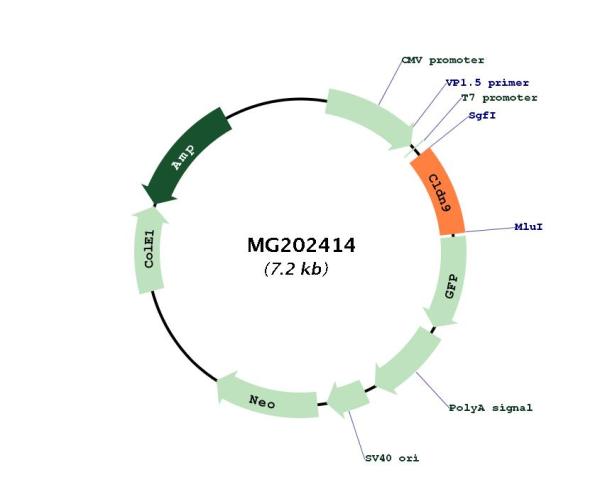Cldn9 (NM_020293) Mouse Tagged ORF Clone
CAT#: MG202414
- TrueORF®
Cldn9 (tGFP-tagged) - Mouse claudin 9 (Cldn9)
ORF Plasmid: DDK
Lentiviral Particles: DDK w/ Puro mGFP w/ Puro
"NM_020293" in other vectors (4)
Specifications
| Product Data | |
| Type | Mouse Tagged ORF Clone |
| Tag | TurboGFP |
| Symbol | Cldn9 |
| Synonyms | nmf32; nmf329 |
| Vector | pCMV6-AC-GFP |
| E. coli Selection | Ampicillin (100 ug/mL) |
| Mammalian Cell Selection | Neomycin |
| Sequence Data |
>MG202414 representing NM_020293
Red=Cloning site Blue=ORF Green=Tags(s) TTTTGTAATACGACTCACTATAGGGCGGCCGGGAATTCGTCGACTGGATCCGGTACCGAGGAGATCTGCC GCCGCGATCGCC ATGGCTTCCACTGGCCTTGAACTCCTCGGCATGACCCTGGCTGTGCTAGGCTGGCTAGGAACTTTGGTGT CCTGTGCCCTGCCACTGTGGAAGGTGACCGCCTTCATCGGCAACAGCATCGTTGTGGCCCAAGTGGTATG GGAGGGGCTGTGGATGTCCTGTGTGGTCCAGAGCACTGGCCAGATGCAGTGCAAAGTATACGACTCACTG CTGGCGCTGCCCCAGGACCTGCAGGCAGCCAGAGCCCTCTGTGTCGTGGCCCTCCTGCTGGCTTTGCTGG GCCTGCTGGTGGCTATCACGGGCGCCCAGTGCACCACGTGTGTGGAGGACGAAGGTGCCAAGGCCCGTAT CGTACTCACCGCAGGGGTCCTCCTCCTCCTCTCGGGCATTTTGGTGCTCATCCCTGTCTGCTGGACAGCC CATGCCATCATCCAGGATTTTTATAACCCACTGGTTGCGGAAGCCCTCAAGAGAGAACTGGGGGCTTCCC TCTACCTGGGCTGGGCTGCCGCTGCCCTGCTCATGCTAGGGGGAGGGCTCCTCTGCTGTACGTGTCCCCC GTCACACTTTGAGCGTCCCCGCGGCCCCAGGCTGGGCTACTCCATCCCTTCCCGTTCAGGTGCTTCGGGA CTGGATAAGAGGGACTATGTG ACGCGTACGCGGCCGCTCGAG - GFP Tag - GTTTAA >MG202414 representing NM_020293
Red=Cloning site Green=Tags(s) MASTGLELLGMTLAVLGWLGTLVSCALPLWKVTAFIGNSIVVAQVVWEGLWMSCVVQSTGQMQCKVYDSL LALPQDLQAARALCVVALLLALLGLLVAITGAQCTTCVEDEGAKARIVLTAGVLLLLSGILVLIPVCWTA HAIIQDFYNPLVAEALKRELGASLYLGWAAAALLMLGGGLLCCTCPPSHFERPRGPRLGYSIPSRSGASG LDKRDYV TRTRPLE - GFP Tag - V |
| Chromatograms |
CHROMATOGRAMS
 Sequencher program is needed, download here. |
| Restriction Sites |
SgfI-MluI
Cloning Scheme for this gene
Plasmid Map

|
| ACCN | NM_020293 |
| ORF Size | 651 bp |
| OTI Disclaimer | Due to the inherent nature of this plasmid, standard methods to replicate additional amounts of DNA in E. coli are highly likely to result in mutations and/or rearrangements. Therefore, OriGene does not guarantee the capability to replicate this plasmid DNA. Additional amounts of DNA can be purchased from OriGene with batch-specific, full-sequence verification at a reduced cost. Please contact our customer care team at custsupport@origene.com or by calling 301.340.3188 option 3 for pricing and delivery. The molecular sequence of this clone aligns with the gene accession number as a point of reference only. However, individual transcript sequences of the same gene can differ through naturally occurring variations (e.g. polymorphisms), each with its own valid existence. This clone is substantially in agreement with the reference, but a complete review of all prevailing variants is recommended prior to use. More info |
| OTI Annotation | This clone was engineered to express the complete ORF with an expression tag. Expression varies depending on the nature of the gene. |
| Product Components | The ORF clone is ion-exchange column purified and shipped in a 2D barcoded Matrix tube containing 10ug of transfection-ready, dried plasmid DNA (reconstitute with 100 ul of water). |
| Reconstitution | 1. Centrifuge at 5,000xg for 5min. 2. Carefully open the tube and add 100ul of sterile water to dissolve the DNA. 3. Close the tube and incubate for 10 minutes at room temperature. 4. Briefly vortex the tube and then do a quick spin (less than 5000xg) to concentrate the liquid at the bottom. 5. Store the suspended plasmid at -20°C. The DNA is stable for at least one year from date of shipping when stored at -20°C. |
| Reference Data | |
| RefSeq | NM_020293.3, NP_064689.2 |
| RefSeq Size | 1443 bp |
| RefSeq ORF | 654 bp |
| Locus ID | 56863 |
| UniProt ID | Q9Z0S7 |
| Cytogenetics | 17 A3.3 |
| Gene Summary | This intronless gene encodes a member of the claudin family. Claudins are integral membrane proteins and components of tight junction strands. Tight junction strands serve as a physical barrier to prevent solutes and water from passing freely through the paracellular space between epithelial or endothelial cell sheets, and also play critical roles in maintaining cell polarity and signal transductions. This gene is developmentally regulated; it is expressed in neonate kidney, but disappers by adulthood. It is required for the preservation of sensory cells in the hearing organ and the gene deficiency is associated with deafness. [provided by RefSeq, Aug 2010] |
Documents
| Product Manuals |
| FAQs |
| SDS |
Resources
Other Versions
| SKU | Description | Size | Price |
|---|---|---|---|
| MC205905 | Cldn9 (untagged) - Mouse claudin 9 (Cldn9), (10ug) |
USD 450.00 |
|
| MR202414 | Cldn9 (Myc-DDK-tagged) - Mouse claudin 9 (Cldn9) |
USD 450.00 |
|
| MR202414L3 | Lenti ORF clone of Cldn9 (Myc-DDK-tagged) - Mouse claudin 9 (Cldn9) |
USD 750.00 |
|
| MR202414L4 | Lenti ORF clone of Cldn9 (mGFP-tagged) - Mouse claudin 9 (Cldn9) |
USD 750.00 |
{0} Product Review(s)
Be the first one to submit a review






























































































































































































































































 Germany
Germany
 Japan
Japan
 United Kingdom
United Kingdom
 China
China

